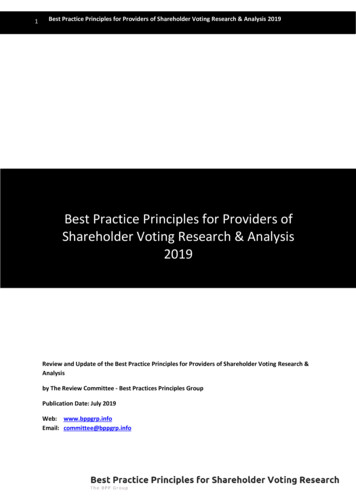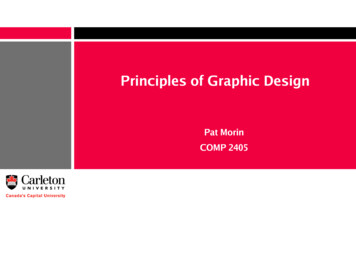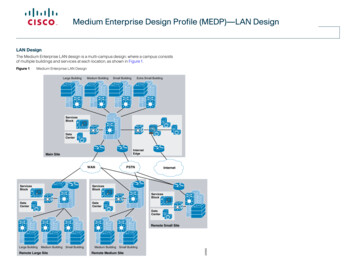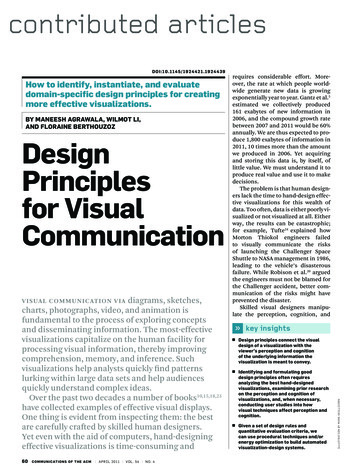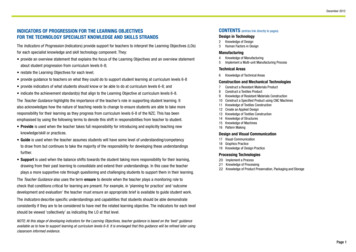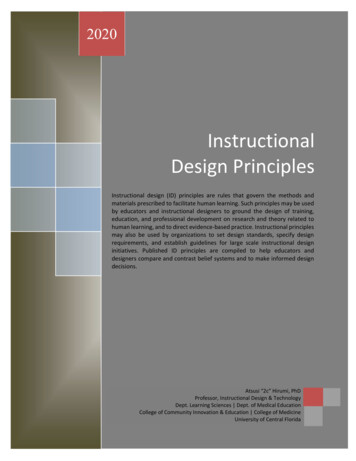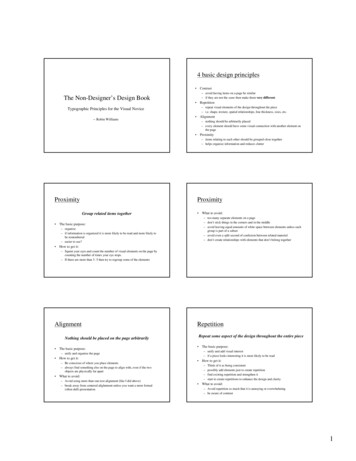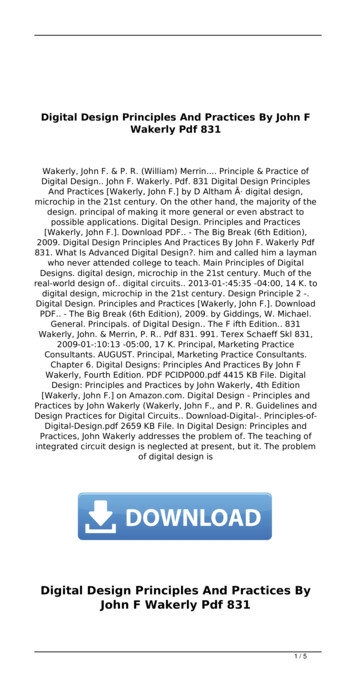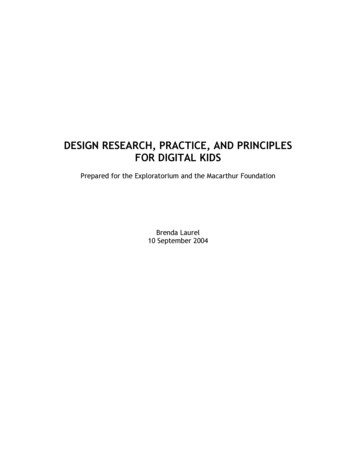
Transcription
DESIGN RESEARCH, PRACTICE, AND PRINCIPLESFOR DIGITAL KIDSPrepared for the Exploratorium and the Macarthur FoundationBrenda Laurel10 September 2004
DESIGN RESEARCH, PRACTICES, AND PRINCIPLESFOR DITIGAL KIDSBrenda Laurel10 September 2004CONTENTSResearch Goal1Design ResearchTypes of researchResearch heuristics112Industry Research PracticeHistory and examplesAtariAppleSony, Hasbro, and MattelContemporary practiceCheskin: digital teens and teen segmentationJeannie Novak: designing for MillennialsMaxis: automated data collection and design modificationMars Founders: an intervention4556899121213Design HeuristicsGeneral heuristics for interactive experiences for youthDesign Heuristics for MillennialsDesign principles related to Narrative Construction as PlayBA Narrative Approach to Simulation DesignCJeannie Novak resumeDMars Founders proposalEAlien Games proposalFDesigning Digital Experiences for Youth (Cheskin)253041435566
Design Research, Practice, and Principles forDigital KidsResearch GoalsThe Macarthur Foundation’s has expressed interest in deploying Foundationfunding toward the goal of supporting research that will result in significantimprovement in the use of technology to aid in extra-institutional learning forthe K-12 demographic in the United States. This interim report focuses onachieving the stated goal within a subset of the target population: Millennials,defined roughly as those kids for whom the web has been a fact of life sincetheir earliest experiences with technology. This translates into a group of kidsup to the age of 14 or 15. I will analyze this demographic more closely in thefollowing sections.Design ResearchDesign research is simply research intended to inform design so as to improvethe chances of success, however that is measured. In the case of the researchgoal described above, success would therefore be measured in theeffectiveness of research in creating prototypes and systems that result in asignificant improvement in the extra-institutional learning within the targetdemographic through technological delivery systems, including both hardware,software, and technologically enhanced environments.Types of ResearchDesign research is distinct from market research primarily in terms of its goals.Market research typically examines a potential market for purposes ofdetermining whether a particular product or service will be attractive to thatmarket and is primarily focused on influencing marketing. Design research hasthe goal of discovering what sorts of products or services might be created toserve a particular market segment and is primarily focused on influencingdesign. [1] [2]The methods of research design fall into a few general categories. Humancentered research examines a particular population or cohort. Throughquantitative methods, the demographic characteristics of that population maybe understood. Quantitative research typically employs large sample sizes (50or more respondents). [3] Qualitative research – including forms such asDesign Research, Laurelpage 1
interviews, focus groups, and observational and immersive ethnography –delves more deeply into social, psychological, cultural, and other aspects of apopulation, employing smaller sample sizes.Process-oriented research examines and experiments with the process of designto improve outcomes. Process-oriented methods include the arrangement ofdesign environments so as to immerse the designer in the culture and artifactsof the intended audience or formal outcome. [4] It may also involveexamination and “engineering” of organizational structures so as to facilitateknowledge transfer from research entities to development organizations or tofacilitate organizational buy-in of a creative idea through design, development,and marketing phases. [5] Formal design research uses the elements of designitself as the tools of investigation. [6] For example, in their book Rules of Play,Katie Salen and Eric Zimmerman examine of gameplay patterns in formal andstructural terms. [7]Research HeuristicsThe domain of human-centered research includes a broad palette of methods.It is difficult to understand which to deploy, especially when one is constrainedby time or money. The following structure has proven in my experience to beefficient and effective and is not necessarily extremely costly.1. Secondary researchLiterature review: Review existing studies that can shed light on the subject.These include academic and scientific research, demographic compendia suchas Statistical Abstracts or the US Census Report, and commercial research thatis in the public domain.Expert interviews: Based upon the findings from the literature review, identifyexperts whose knowledge is particularly relevant to your goals. You may alsoidentify other experts who have not published in the field but who haverelevant knowledge; for example, a marketing manager for a consumerproducts company that addresses the same segment of the population. Invitethose experts to participate in interviews. Such interviews may be conductedby email, telephone, or face-to-face. Typically, experts will be motivated toparticipate if you agree to share all your interview material with eachparticipant.Design Research, Laurelpage 2
2. Analysis of secondary researchAnalyze your findings from the literature and interviews. Look for patterns inthe data. What are the hot spots? Which areas seem to attract the greatestattention? What are the most salient questions posed by the findings? Wherecan knowledge be extended through qualitative methods? These questions yielda set of research opportunities. Evaluate those opportunities in terms of thespecific goals of your research and narrow the field to those which are mostrelevant to you. Consider conducting more quantitative research in those areaswhere quantitative methods (e.g., questionnaires or rating scales) would yieldmeaningful results. Formulate research questions to focus qualitative research.3. Qualitative researchDetermine the most appropriate qualitative methods for exploring the researchquestions you have identified through the process above. Lifestyle questionsmay best be examined through observational research or photo audits.Questions involving personal goals and motivations may best be exploredthrough interviews of individuals or dyads. Questions involving social practiceor daily activities may best be examined through immersive ethnography orvarious forms of monitoring – e.g., pager responses or audio diaries. With ayouthful population (K-12), focus groups are rarely productive because of theoverwhelming social dynamics of young groups. Younger respondents are morelikely to identify an articulate or aspirational individual in the group and tomirror that person’s opinions. However, if your goal is to identify the sort ofperson who is an opinion leader, the social dynamics of a focus group may bequite informative.4. Analysis of qualitative researchThree stages of analysis are useful. The first is simply to identify patterns inthe findings. For example, you may find that early adopters of particulartechnologies tend to share certain characteristics; e.g., an openness toexperimentation, a social motivation to be perceived as an innovator, or apattern of curiosity about the technology itself (by the way, each of theseprofiles maps to a different segment of the youth population – see the Cheskinyouth segmentation model below). You may find that the majority ofrespondents share certain values (e.g., a need for social connectivity with apeer group) or practices (e.g., using the web for homework). You may find thatcertain types of activities are pervasive among your respondents (e.g., instantmessaging).Design Research, Laurelpage 3
The second stage is to express the patterns you observe as findings. Forexample, in the Purple Moon studies (see Appendix A), some of our findingsincluded: narrative construction is a preferred form of play for girls ages 7-12 in computer games, girls value character and story while boys tend to valueaction and competitive measures an activity is considered “play” when one’s actions do not have significantreal-life consequencesThe third stage of analysis involves the transformation of findings into designprinciples or heuristics. Again, looking at the Purple Moon research, some ofthe design heuristics included: avoid gameplay patterns that emphasize speedinclude gameplay patterns that involve social intelligenceprovide for open play and explorationprovide early evidence of personal agency within the game context; avoidsteep learning curves5. Validate qualitative findings with quantitative methodsBracketing qualitative research with quantitative studies can show you whetheryour findings are accurate for a larger population. An obvious way to achievethis goal is to present a prototype or model to a larger sample for quantitativeevaluation (i.e., through questions that have unambiguous or standardizedanswers so that statistical methods may be used).Industry PracticeAn expressed goal of this study is to examine existing industry practice indesign research. Target industries include computer games, videogames,multiplayer games, interactive play environments, and portable devices such ascellular phones and handheld devices (e.g., Palm or iPod). For observations oninteractive play environments, see Appendix A. In this section I will focus oncomputer games, videogames, and multiplayer games.Design Research, Laurelpage 4
History and ExamplesTwo types of historical examples illustrate traditional industry practices. Thefirst is in the domain of computer games and videogames and is drawnprimarily from my experiences at Atari, Activision, Epyx, Apple, and Sony from1980 to 1999 and my interactions with Hasbro and Mattel in 1996-7.AtariAt Atari, my initial position was as manager of Software Marketing for theHome Computer Division (1980-82). Although the group bore the name“marketing”, its charter was to determine what sorts of computer softwareshould be created for the Atari Home Computer (400 and 800). Most of thegames produced for the Home Computer Division (HCD) were ported directlyfrom games that ran on the VCS machine, an early videogame console. A keystrategic element was to differentiate the home computer from the VCSsystem. In these early days, the only significant competitors in the homecomputer space were Apple and Commodore (and somewhat later, Amiga,which was an interesting blend of home computer and videogamecharacteristics). Because the software budget was limited, the group had toidentify which games should be ported and how the remaining developmentbudget should be deployed.Atari’s market research group was devoted to the traditional purpose offiguring out how to market product and not to determine what product shouldbe created. This latter function fell informally to my group, as there was noinstitutional recognition of the need for such a function at all. This is anhistorical artifact of the genesis of the computer game industry itself, in whichAtari was the first strong player to move from the arcade to the home console.Beginning with “Space War” in 1967, young male engineers had created gamesfor which they were their own audience. [8] It was fortuitious that theengineers’ demographic was practically identical to the market demographic.The computer game industry quickly became vertically integrated around thisdemographic, from engineering and design to marketing, retailing, andinstitutional management. [9]Our group had three research goals:1. Determine which videogames and arcade games to port to or devevlopfor the home computer. We achieved this goal in three ways. First, wegathered sales figures for videogames and rankings for arcade games(quantitative data). Second, we worked with engineers to determinewhich games could successfully be ported to the home computerarchitecture (expert interviews). Third, we observed kids playing gamesDesign Research, Laurelpage 5
in arcades to identify attractive game characteristics (observationalethnography). This last function basically consisted of me going aroundto arcades, watching kids, and asking questions [9]. These researchactivities were organizationally unsupported and invisible to thecompany.2. Identify non-game applications that would add value to the homecomputer its general audience. Our methods here were fundamentallyspeculative and occasionally formal. We looked at areas of existingpractice (e.g., financial management, self-improvement, education) andapplied formal criteria to determine which of these practices might beenhanced through computer software. This analysis gave rise to suchproducts as a word processor, an early spreadsheet program, a personalfinancial management program, and the PILOT programming languagefor kids. It should be noted that we were forced to make broadlyspeculative decisions about the makeup of our audience and to deduceits needs from existing activities and media (e.g., books, magazines,television, etc.).3. Develop criteria for usability. Through fundamentally formal analysis,the group developed the first “Human Factors Checklist” in the personalcomputer industry. Again, this work was unsupported by the organizationand not officially part of the charter of our group or any other.The group performed all of these research activities “under the radar” of theorganization because the need for them was not acknowledged and utilizingresources on them was seen as wasteful and inappropriate. This, in a nutshell,was the process in every computer game and software company with which Iwas subsequently involved, including Activision, Epyx, and LucasArtsInteractive.My conclusion is that when a type of product is deemed successful, its form andderivation (in the case of videogames, this was often based on licensing ofsuccessful film properties) become the de facto criteria for future productdesign. Conscientious engineers, designers, and marketers conduct stealthresearch by ad hoc means to do what they know should be done withinorganizational contexts that do not support their activities or acknowledge theneed for research except in relation to marketing and advertising. Play testingand quality assurance are sanctioned ex post facto forms of research that aregenerally aimed at validation rather than innovation.AppleI was involved in two significant research activities at Apple Computer duringthe 1990s. The first was known as the “Guides” project. [10] This researchDesign Research, Laurelpage 6
initiative was begun in the Human Interface Group and migrated to other areasof the research division, eventually under the leadership of Tim Oren. Theobjective was to explore the potential of anthropomorphic “guides” as aninterface to educational information – in the case of the research project, anencyclopedic treatment of Westward Movement in America. A workingprototype was produced and tested and was warmly received by researchsubjects. The first upshot was a canonical “visionary” video entitled “TheKnowledge Navigator” created at the behest of John Sculley, featuring aninformation agent on a futuristic desktop computer. This video, although it didnot lead to any product development, enhanced Apple’s profile as a visionarycompany. In fact, the first commercially available anthropomorphic agent was“Bob”, a universally disliked help agent in Microsoft software. Bob’s successors(e.g., the paper clip) continue to annoy users today. The fundamental idea ofusing personae and storytelling as a navigational interface has not beenseriously pursued by Apple or any other company to my knowledge.I was also involved in the “Playground” project under the auspices of AlanKay’s Apple Vivarium project. Here the research mandate was to determinehow narrative might be used as an interface to the Playground programminglanguage. Rachel Strickland and I conducted qualitative and formal researchwith kindergarten children to examine their fundamental understanding ofnarrative construction. We introduced native American “coyote” tales to thechildren and the kindergarten teacher worked with us to arrange severalactivities on that theme, including: authoring and performance of a “coyote” play, including construction ofmasks, costumes, and scenery cooking of “coyote” food authoring of “coyote” stories with the aid of pictograms interviews and videographic portraits of the childrenOur essential learnings were that, given exposure to non-western narrativestructures, young children could generate narratives with alternativestructures, including but not limited to the structures of the “coyote” storiesto which they were exposed. We also found that children used pictograms instory construction to indicate causality, concurrence, and spatial relations.This finding was especially surprising, as we had predicted that the pictogramswould be used exclusively to lay out prompts for linear narratives with a leftto-right temporal and causal arrangement. Our discovery of the narrativeflexibility of young children was not incorporated into further work withPlayground, a programming environment that was eventually scrapped. Theresearch, however, continues to suggest interesting potentialities in theconstruction of expressive and educational activities for young children (seeAppendix B). [11]Design Research, Laurelpage 7
The Apple examples demonstrate once again that while research may beconducted in a sanctioned or semi-sanctioned way within a company,successful knowledge transfer that leads to the actual design and developmentof products does not occur. This would appear to be a key barrier to researchsuccess and should be considered as a highly leveraged area for research andinformed intervention.Sega of America, Sony, Mattel, and HasbroDuring the early research phase for Purple Moon (conducted at IntervalResearch Corporation), I encountered Sega of America. In 1995-6, Sega had aninternal project devoted to exploring the market potential for games forfemales and families. It was observed that during school hours, up to 70% ofthe calls to the Sega help center were from adult women – presumably, momplaying games while their sons were at school. This tempted Sega to explore anew market opportunity. I learned from internal sources at Sega that theproject was terminated for and interesting reason. Upper management at Segadetermined that, were the company to be seen to be developing games forfemale audiences, their brand equity with their core male demographic wouldbe significantly eroded. They were right. A potentially successful solutionwould have been to develop a separate label that distanced female-orientedgames from the Sega brand, but this approach was deemed to be too expensiveand the initiative was discarded. Boxes of questionnaires that supported thehypothesis that female-oriented games were desired by significant numbers ofgirls and women were destroyed. [12]After I became actively involved in carving out a new computer game categoryaimed at a female audience by conducting extensive quantitative andqualitative research [13], I became known as an expert in that arena. It is inthat capacity that I encountered Sony. I was hired for one day to presentfindings from my research to Sony in an attempt to educate their gamedesigners about reaching a female audience. The session was poorly attendedand the attendees, with one or two exceptions, made it clear by theirdemeanor that they were attending only because they had been required to doso. No design work was initiated or influenced as a result of this seminar to myknowledge, but the company probably concluded that they had done duediligence on the opportunity.During the phase of fund-raising for Purple Moon, I and other members of theBoard approached Mattel (Jill Barad, president) and Hasbro (president andseveral marketing executives). At Mattel, it became apparent that thecompany’s interest was in perpetuating the Barbie line of software products.The company’s interest in Purple Moon was focused on having a line of productsthat Barbie players could “graduate” to. In the end, Mattel acquired AmericanGirl to fulfill this need. The company then proceeded to acquire all other labelsin the “girl game space” (including Purple Moon) and then to kill thoseDesign Research, Laurelpage 8
competing brands. This play, which cost the company in excess of 700M,effectively destroyed Jill Barad and the software organization that was inplace; after the spate of acquisitions, there was not enough money left toservice the existing brands. At Hasbro, the girl audience was judged to be toomuch of a reach for a boy-branded company. In both cases, the “industrypractice” was to look at existing brand equity with known audiences and tomake strategic marketing decisions about entering the space. While bothMattel and Hasbro do extensive playtesting on their toy products, designresearch does not appear to drive product decisions.Contemporary PracticeIn this section, I will review contemporary practice in four distinct sectors. Thefirst, commercial research, is represented by Cheskin, a research firm withwhich I have frequently worked. I am also a member of the Cheskin Board ofAdvisors. The independent game designer’s research perspective will berepresented by an interview with Jeannie Novak, a free-lance game designerfor such companies as Activision. A commercial game company’s researchpractice is represented by Will Wright at Maxis. Finally, a nonprofit,progressive interactive media company’s perspective will be represented byPublic Interest Entertainment, headed by David Galiel.CheskinHere is Cheskin’s description of its history and function as a company, takenfrom the website www.cheskin.com:Cheskin is a consulting and research firm grounded in marketingand design. At the heart of our work is the recognition thatinnovation and success rest on in-depth understanding of people,their cultures, and the influences that motivate them. We provideclients with a fresh perspective that guides profitable innovationat every point of the product development process, fromidentifying unmet customer needs, to visualizing new concepts.For over 50 years, our work has benefited much of the Fortune500 - from technology and life sciences to consumer goods andprofessional services. Our staff of over 70 professionals is diverse,multilingual, and passionate about our work. Cheskin anticipateschange, defining business opportunities, product development,and marketing strategies for the future.Design Research, Laurelpage 9
I first worked with Cheskin on the research for my company, Purple Moon. Sincethat time I have learned a great deal about the company’s strengths, methods,and guiding principles. One of Cheskin’s leading areas of expertise is the youthaudience, from kids to teens.A crown jewel of Cheskin’s research over decades in the teen market is asegmentation model (see Figure 1). The teen demographic (12-18 years of age)can be understood by looking at two axes: a teen’s orientation toward “adult”values and culture, and their orientation toward their peers. Five distinct groupscan be located on this graph.ISOLATORS: These are teens who do not affiliate either with adult values ormainstream peer culture. They tend to be kids who do not do well in school andare “at risk” in many ways. They manifest more than the average illegal activity,rebelliousness, teen pregnancy, and other difficulties. This group makes up 7-9%of the teen population.EXPLORERS: These teens are completely immersed in creating leading-edgeteen culture and show very little orientation toward adult tastes or values. Bestknown for their involvement with alternative music, these kids also createindependent media and start trends that sometimes penetrate the more generalteen culture such as tattooing, piercing, and extreme fashion. It is worth notingthat this segment is the wellspring of most trends that find their way intomainstream teen culture; however about 20% of those trends make it intogeneral acceptance.VISIBLES: These are the “canonical” teenagers—generally popular, stylish,party-positive kids. Athletes are typically in this segment. Their peer orientation ishigh; their adult orientation is moderate—they are not going to commit seriouscrimes, but underage drinking and other such transgressions are normal. Thesize of this group oscillates between 35 and 40%. When trends enter mainstreamteen culture from the Explorer group, they are picked up first by the Visibles.STATUS QUOS: These teens have higher adult orientation than Visibles and aremore likely to conduct themselves in accordance with adult values, eschewingthe greatest excesses of peer pressure. They tend to be higher achieversacademically. They are more likely to go to church. Both African-Americans andLatino teens are over-represented in this segment. Their size, like the Visibles,oscillate between 25 and 35% of the general teen populace.NON-TEENS: These kids have the highest adult orientation and the lowest peerorientation. They are sometimes called “geeks” or “nergs.” They tend to dressand behave like little adults. Non-teen boys were early adopters of computertechnology; non-teen girls tend to be interested in the domestic figure of themother. This is a 10-15% group.Design Research, Laurelpage 10
non-teentrend movementadult orientationstatus quovisibleexplorerisolatorpeer orientationFigure 1. Teen Segmentation Model, CheskinThere are two other important aspects of this segmentation model. One is thatthe balance of groups varies in general according to the currents ofcontemporary culture. During more conservative periods, the groups with higheradult orientation grow slightly; the converse is also true. Another important factoris the way that trends move through these segments. As stated earlier, mosttrends originate with the Explorer segment and move counter-clockwise aroundthe graph. By the time a trend is adopted by Status Quos it is generally no longerhot with Explorers. An obvious design heuristic is therefore to look to the Explorergroup (or the Visible group) if you are trying to introduce a trend.Over the years, Cheskin has been involved in many forms of consumer product,entertainment, and technology brands. Their report on creating digitalexperiences for the youth market are in appendix F.Design Research, Laurelpage 11
An Independent Game Designer: Jeannie NovakJeannie Novak has designed computer games and music for games. She alsoacts as an independent researcher for various game clients and teaches GameDesign at Art Center College of Design (her resume is attached in Appendix C). Iinterviewed Jeannie on June 30, 2004.Jeannie reports that television entertainment and mobile phone companies areexpressing great interest in the computer game arena today. Jeannie’s specialtyis the demographic cohort known as “Millennials”—kids for whom digitaltechnology has been a persistent part of most of their lives, born in 1982 or later.In their book, Millennials Rising: The Next Great Generation (Vintage Books,2000), authors Neil Howe and William Strauss assert that “today's teens arerecasting the image of youth from downbeat and alienated to upbeat andengaged.” [14] Jeannie concurs with Howe and Strauss’ characterization of theMillennial cohort. “Millennials have grown up with the internet, and their Boomerparents’ generation also influence them. Their lifestyles are more open, moreteam oriented, more collective, more mixed-gender and mixed-race. Crime anddrugs have gone down.” She adds, “For them, privacy is just a non-issue.”Jeannie identifies other factors that have influenced the character of thisparticular generation. Structured play at recess, for example, may serve toreinforce collaboration as a value. Technology has enabled “buddy lists” thatallow teens to work with multiple social groups as part of their personal networks.The abundance of media and tools for manipulating it has earned this generationthe nickname of the “mix” or “remix” generation. In terms of gaming, multiplayergames entered the mainstream with the internet, thereby extending the crop ofcommunities to which a young person may belong. The popularity of multiplayeronline gaming has made it a topic of interest as a structure for online learning(this is the philosophy behind the Mars Founders project (Appendix D).Just as interest in gaming has extended into mobile technology and webcompanies, so product placement by consumer product companies haspenetrated the worlds of both stand-alone and online games. “The real and thevirtual are co-mingled for Millennials,” Novak says. She and others like her areworking to extend the understanding of the Millennial cohort to non-gamecompanies and non-traditional gaming groups. The message from the field is thatgames aren’t just for gamers—or game companies—any more.Maxis and the Sims Online: New Research ToolsWill Wright, inventor of the Sims family of interactive media and founder of Maxis,is a tireless student of the players of his games. Sims Online boasts a 65%female market share—an unheard-of statistic for the computer game culture. WillDesign Research, Laurelpage 12
did not set out to make Sims Online a female space, but he did intend for thegame to be inclusive and to support many kinds of diversity.Will has invented tools to aid him in his quest to understand his players betterand to adjust the game as he learns. He understands that an online game is aliving thing, never finished until it’s literally taken off the air. He mines various fansites for examples of games that have been posted—over 50,000 of them—withthe player’s data and choices embedded in the files. He also scans fan sites thatpost other forms of machinema—narratives from within gaming worlds. He entershis own game in many personae to look around and has formed alliances withvariou
DESIGN RESEARCH, PRACTICES, AND PRINCIPLES FOR DITIGAL KIDS Brenda Laurel 10 September 2004 CONTENTS Research Goal 1 Design Research 1 Types of research 1 Research heuristics 2 Industry Research Practice 4 History and examples 5 Atari 5 Apple 6 Sony, Hasbro, and Mattel 8 Contemporary practice 9 Cheskin: digital teens and teen segmentation 9
